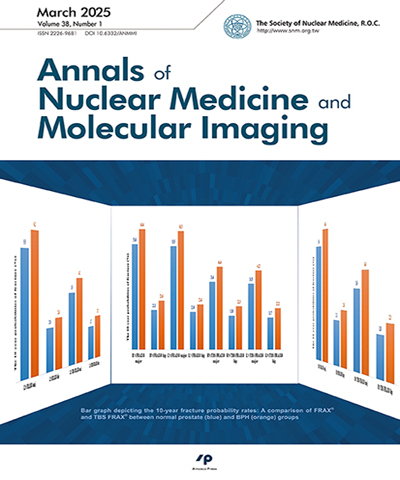
核子醫學暨分子影像雜誌/Annals of Nuclear Medicine and Molecular Imaging
中華民國核醫學學會 & Ainosco Press,正常發行
選擇卷期
- 期刊
背景:根據世界衛生組織2008年開發評估病患骨折風險的工具(FRAX®),可整合相關臨床危險因子及股骨頸的骨密度,推算病人未來10年主要骨鬆骨折與髖骨骨折之機率,建議40~90歲的人,若主要骨鬆性骨折風險>20%,及髖部骨折風險>3%時就應接受骨鬆治療。然而,在一般的臨床經驗裡,我們卻經常發現某些族群,即使骨折風險不高仍有發生骨鬆骨折之現象。因此本篇研究將進一步分析本院50歲以上族群的患者,就骨折史與骨折風險相關之分析,臺灣中老年以上族群的骨折風險閾值是否根據不同年齡層來建立治療指引,以提供臨床人員作為骨鬆治療介入時機之參考。方法:本篇為回顧性研究,收集2014年11月至2021年03月間,曾接受雙能量光吸收測量的門診與住院患者之病歷紀錄。排除條件為骨質密度3個部位中單一部位無法評估之患者(包括腰椎區域鋼釘內固定或椎體成形術、單側或雙側髖部鋼釘內固定或髖關節置換手術)或年齡小於50歲受檢者。最終收集8,049位受檢者資料,男性為1,303名(16.2%),女性為6,746名(83.8%)。將患者的理學檢查、過去病史、骨鬆骨折史、生活型態與10年骨折風險進行分析。結果:經過統計分析發現三個族群之間之理學檢查、過去病史、骨質密度、10年骨折率皆呈顯著差異。其中,10年骨折風險各組間隨年齡增加,且各年齡群組中部分未達建議之治療標準即可能產生一個或一個部位以上之骨折。低骨密度與高FRAX®是骨鬆性骨折獨立且重要之因素。結論:我們發現,曾經骨折之患者骨質密度比未骨折之患者骨質密度低。當利用FRAX®評估受檢者骨折率時,50歲以上受檢者,建議應根據不同年齡層,調整治療的FRAX®閾值,將有利於對中高風險的骨鬆患者及早提出接受治療與追蹤的建議。
- 期刊
背景:全身骨掃描是臨床核醫學檢查中常見的檢查之一。雖然知道其輻射劑量低,但臨床很少實際測量人體的體內吸收劑量。本研究使用個人劑量計來評估核醫學骨骼掃描患者的吸收劑量,以及在臨床上有那些應用層面。方法:在2020年11月至2021年5月共收集209位受檢者,其中男69例,女140例,年齡24~92歲之間。使用個人劑量計在注射^(99m)Tc-MDP後30分鐘、120分鐘和180分鐘後,在距離患者30cm處測量輻射劑量率。之後使用STATISTICA 7.0軟體將人體的5個重要因子分析後得到一個半經驗公式,利用半經驗公式可快速預估藥物在體內停留的時間,及推算體內吸收劑量。結果:經由統計計算後,得到性別、年齡、身體質量指數(body mass index, BMI)、在胸腹體內滯留(平均壽命)時間,以及人體吸收劑量和體表劑量。之後使用SPSS軟體,平均壽命在胸部性別組和胸腹部年齡組中具有統計學意義(p<0.05)。藥物停留時間在± 20%的誤差範圍內,預測的準確度達到了80%。體內吸收劑量的預估也有70%的準確度,表示此研究匹配度良好。結論:在臨床作業的角度來看,受檢者在檢查前可利用人體5大因子,快速的預估^(99m)Tc-MDP檢查的體內停留時間及體內吸收劑量。此資訊還可提供給輻射防護人員做進一步輻射防護的參考。
- 期刊
A 50-year-old male went to the preventive medical center of our hospital for examination. Bone mineral density (BMD) testing showed an abnormally high value of the left femoral neck compared to the right side. The patient had previously received only surgery for a ruptured left elbow ligament. Hypertension, diabetes, and hyperlipidemia were also found, as well as high levels of triglycerides and low thyroid stimulating hormone. The patient was diagnosed with hip subchondral lucencies and sclerosis which resulted in increased BMD.
- 期刊
Carcinoembryonic antigen (CEA) is a substance found on the mucosal cells. The use of CEA is a blood test that helps diagnose and manage certain types of cancers. The CEA test is used, especially for cancers of the colon and rectum. However, there are other conditions of elevated CEA level. In this paper, a case of elevated CEA level in a 25-year-old man who has been diagnosed with medullary thyroid cancer is reported.
- 期刊
背景:本篇研究目的將探討三個部位(腰椎與雙側髖部骨質密度)均能分析與單一部位不能分析(腰椎與雙側髖部骨質密度任一部位)-因手術而無法分析,二組間各部位的骨質密度差異性,也進一步探討十年骨折率的變化。方法:本篇為回溯性研究,收集自2014年11月至2021年3月間,於臺灣南部某區域教學醫院,接受門診骨質密度檢測之受檢者,將受檢者分成二個組別,控制組(腰椎、左側髖部、右側髖部)三個部位均能分析,手術組(腰椎、左側髖部、右側髖部)只要一個部位開刀,不包含同時二個部位開刀,我們依據受檢者開刀部位分成二組分析。手術包括脊椎手術史(鋼釘內固定、椎體成形術或金屬植入物),髖部手術史(全髖關節置換手術或鋼釘內固定)。結果:本篇研究初步發現,利用骨質密度檢測三個部位,當有一部位因手術後無法評估時,與三個部位都能評估相比,將因手術部位影響骨密度評估,手術患者仍較控制組其骨質密度數值較低,骨折風險增加。結論:因此,本篇研究結論,研究發現金屬植入物固定手術後骨質密度會相較於控制組低,相對骨折率也比控制組高。因此未來建議臨床醫師定期追蹤金屬植入物術後骨質密度之變化,以降低再次骨折之狀況。
- 期刊
Background: The purpose of this research was to determine the cut-off value for head and neck (H/N) cancer by using semi-quantitative analysis and visual interpretation of skull base invasion. Methods: This is a retrospective study. From January 2011 to December 2012, we collected 1,015 consecutive patients referred for a whole body bone scan (WBS) to detect H/N cancer. Among them, 90 patients were female and 925 were male. We enrolled patients who received WBS and an additional single-photon emission computed tomography/computed tomography (SPECT/CT) of the H/ N area. Receiver operating characteristic (ROC) analysis of the area under the curve (AUC) was done to determine significance. Results: About 47.8% of planar bones showed visually abnormal uptake at the skull base on WBS. The remaining planar bone scans (52.2%) had normal findings at the skull base. Only about 26.1% of SPECT/CT showed visually abnormal uptake at the skull base, with 73.9% of normal findings at the skull base. ROC curve analysis showed the AUC of WBS was 62.6%, and that of the SPECT/CT was 89% (p < 0.005). The cut-off value was determined by ROC curve analysis. With a cut-off value of 1.965, the sensitivity of WBS was 73.6%, and the specificity was 44.9%. With a cut-off value of 6.94, the sensitivity of H/N SPECT/CT was 84.2%, and the specificity was 77.1%. Conclusions: Using semi-quantitative H/N SPECT/CT can facilitate the determination of the cut-off value for the interpretation of skull base invasion. This method was more sensitive than conventional bone scintigraphy and can help improve the confidence of nuclear medicine physicians in diagnosing H/N cancer. For patients suspected of having H/N cancer, more information can be obtained when a H/ N SPECT/CT is routinely added to WBS.
- 期刊
Peritoneal cerebrospinal fluid (CSF) pseudocyst is a complication of a ventriculoperitoneal shunt (VPS), which rarely occurs in adults, so such case reports are rare. We report here that the recurrence of hydrocephalus in an adult patient was caused by a rare peritoneal CSF pseudocyst, which was confirmed by subsequent scintigraphy and computed tomography (CT). A 60-year-old woman presented with clinically progressive weakness of the lower limbs, unable to walk, silence and slow speech, bilateral hearing impairment, and urinary incontinence, but no headache, diplopia, nausea, and vomiting. The results of brain CT showed hydrocephalus. Therefore, she underwent surgery to insert the VPS, and then she recovered as usual. One month later, she underwent a brain CT follow-up examination, which showed that the ventricles had shrunk. About 8 months after the shunt procedure, her previous symptoms reappeared. In the beginning, she also had fever, nausea, and vomiting. During the physical examination, only the muscle power of the limbs decreased (grade 3), and other neurological examinations were normal. The abdomen was oval in shape, without focal tenderness. When she was in the emergency room, her fever had subsided. The test results of blood and CSF were within the normal range. Subsequent CT of the brain confirmed the recurrence of hydrocephalus, so she was referred to the Department of Nuclear Medicine for VPS examination. A rare peritoneal CSF pseudocyst was accidentally discovered, which was confirmed by abdominal CT. After the patient received a new replacement of the VPS, the symptoms disappeared and the original function was restored.
- 期刊
A 34-year-old woman hospital personnel received her yearly follow-up fluorodeoxyglucose (FDG) positron emission tomography (PET) 4 days after the AstraZeneca COVID-19 vaccination. The PET images demonstrated new FDG uptakes at the left axilla and the left upper arm. After reviewing her clinical history, the FDG uptake at the left axillary lymph nodes (LNs) was attributed to the reaction to vaccination. This instance suggests that newly ipsilateral axillary LNs with FDG uptake after vaccination should be interpreted with caution. Vaccination history and the injection site should be inquired to avoid false-positive PET image interpretation and unwarranted biopsies.

